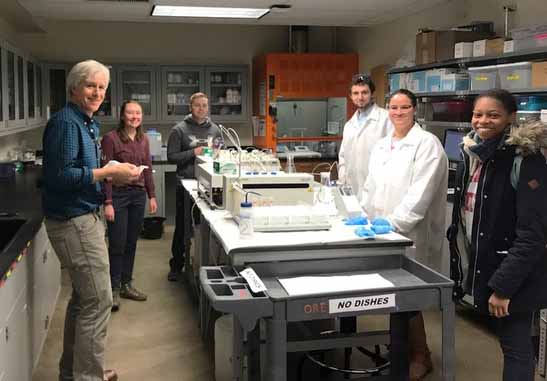Laboratory Focuses on Bloomington Lake

Dr. Bill Perry meets with students in the Laboratory of Environmental Analysis at Illinois State University. (Photo courtesy of: Illinois State University Laboratory of Environmental Analysis)
A new laboratory at Illinois State University is providing an important water quality testing source for local agencies and an invaluable learning experience for students.
The university’s Department of Geography, Geology, and the Environment opened the Laboratory for Environmental Analyses (LEA) in 2017. The laboratory’s first full year was a resounding success with 6,700 water quality samples tested for dissolved nutrients and the employment of graduate and undergraduate students.
“We currently have four internal clients just from our university and seven external clients for which we perform analysis,” said Dr. Bill Perry, director of the laboratory.
The LEA evolved from the need to study local water sources to examine how certain farming practices could affect water quality in the streams entering Lakes Bloomington and Evergreen. The two lakes provide water to Bloomington, Illinois residents.
“The streams leading into the lakes have occasionally exceeded the drinking water nitrate limit and have to go through a mediation process,” explained Perry. “The water at various times has been above 11-15 milligrams of nitrate-nitrogen per liter. Because of that, many agencies and universities want to know what is entering the lakes.”
Aside from scientists and students at Illinois State University, those interested in learning more about the water quality in regional streams include the Environmental Protection Agency, Nutrient Research Education Council, The Nature Conservancy, Illinois Corn Growers Association, City of Bloomington, University of Illinois Urbana-Champaign, and University of Illinois-Springfield.
The local agricultural industry, comprised of mainly corn and soybean farms, is the main cause of the high nitrate levels. According to Perry, the primary focus of most of the research is the need to understand how current and alternative sustainable farming practices affect the water quality. Between 2000-2013, the number of testing samples brought to the university for testing steadily grew.

A student works with a flow injection analysis machine in the Laboratory of Environmental Analysis at Illinois State University. (Photo courtesy of: Illinois State University Laboratory of Environmental Analysis)
“In 2013, we applied for a National Science Foundation major instrumentation grant and were able to purchase a flow injection analysis machine that allowed us to run many samples, much faster,” said Perry.
The university’s Department of Geography, Geology, and the Environment was joined by the U.S. Department of Agriculture in its efforts to test and learn from local water quality. The new laboratory provides a centralized place for testing.
“The laboratory currently has $2 million in grants from a variety of sources that help with equipment and paying our personnel,” said Perry. “We also charge per sample to help pay our laboratory manager and other student workers.”
Perry and Illinois State University are dedicated to making the LEA an informative learning experience for students.
“Working in the laboratory gives students a hands-on experience in a cutting-edge laboratory that uses EPA certified methods and quality analysis/quality control that are used in the real world,” said Perry, “They also learn how to manage the data and work with data sharing methods.”
Perry also provides additional instruction on how to manage large volumes of data.
With the new facility up and running and a solid educational experience in place for students, the LEA team is now looking towards next steps and growth. The team plans to apply for additional grants in order to add more equipment and testing capabilities.
“Ideally, we would like to renovate more space and continue our work with the community,” said Perry.

Students weigh test-tubes for persulfate digestion in the Laboratory of Environmental Analysis at Illinois State University. (Photo courtesy of: Illinois State University Laboratory of Environmental Analysis)




Pingback: Laboratory Focuses on Bloomington Lake - Lake Scientist